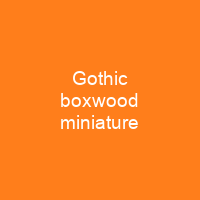Discover the Intricate World of Gothic Boxwood Miniatures
Gothic boxwood miniatures are like tiny masterpieces, hidden treasures from a bygone era. Imagine holding in your hands a sculpture so detailed that it seems to breathe and tell stories. These exquisite works of art were created during the 15th and 16th centuries in the Low Countries, and they continue to captivate us with their intricate layers and rich Christian themes.
What Exactly Are Gothic Boxwood Miniatures?
Gothic boxwood miniatures are spherical rosary beads, statuettes, skulls, coffins, or altarpieces, typically measuring 10-13 cm in height and 3.9-5.1 inches in diameter. They consist of highly intricate layers of reliefs made from boxwood, a fine-grained hardwood suitable for detailed micro-carving. These miniatures are not just small; they are masterpieces that require exceptional craftsmanship to create.
The Craftsmanship Behind Gothic Boxwood Miniatures
Producing these miniatures was no easy feat. The artisans involved had to possess a level of skill and dedication that few can match today. A workshop led by Adam Dircksz produced dozens of works, but little is known about him or the other artisans who contributed to this art form. The tools used included saws, planes, chisels, and lathe-turning tools to create intricate scenes on the miniatures.
Designs were overseen by master craftsmen influenced by contemporary artworks. Due to their small scale, magnifying glasses were essential in their production, which was challenging due to the difficulty of bracing the wood pieces during carving. The layering technique allowed for the creation of intricate details such as tiny drilled holes for punctuations and textured scales on dragon skins.
Adam Dircksz: A Master of Miniatures
Only one miniature is explicitly dated (1511), but most have approximate dates inferred from inventory records. The majority are attributed to Northern Renaissance artisans working in the Burgundian and Habsburg Netherlands during the late 15th and early 16th centuries, despite initial assumptions of a Southern Dutch origin. Adam Dircksz is credited with producing many of these miniatures due to shared characteristics found on his name.
Dircksz was active between 1500 and 1530, responsible for around sixty examples, possibly from a workshop in southern Netherlands or northern Brabant. His work reflects the Christian sculpture traditions of the time, similar in style to Flemish panel paintings and altarpieces, with iconography often combining Old and New Testament scenes.
Types of Gothic Boxwood Miniatures
The miniatures follow Christian sculpture traditions, similar in style to Flemish panel paintings and altarpieces. They are categorized into two groups: simple reliefs and complex designs. Most take the form of prayer beads, statuettes, round pendants, coffins, perfume flasks, or memento mori in the form of skulls.
One style superimposes intersecting circles around the head of a dome, while another uses small circles to punctuate and divide the dome into segments. A third style combines both, using arcs of circles to link them with repeating patterns. The Prayer nut is a beaded object with a central scene depicting episodes from Mary’s life or the Passion of Jesus.
Functions and Impact
Gothic boxwood miniatures served three original functions: aids to private devotion, luxury objects of status, and novel playthings. The earliest record of a collection is the 1598 inventory of the dukes of Bavaria. Over one hundred re-emerged in the 19th century Parisian antiquarian market, acquired by collectors such as Richard Wallace, Frédéric Spitzer, and Ferdinand de Rothschild.
Spitzer commissioned modern versions or copies of medieval artworks, including four surviving boxwood carvings he had augmented for the market. J.P. Morgan purchased Baron Albert Oppenheim’s collection in 1906, acquiring four boxwood miniatures, including a triptych with the Crucifixion and Resurrection. Kenneth Thomson’s collection included the world’s largest gathering of boxwood miniatures.
Modern Imaging Technology
Objects are difficult to view with the naked eye and require magnified reproductions or computer modeling to convey their intricacy. Modern imaging technology has improved the study of objects since the late 20th century, including X-ray and micro-CT scanning.
The Art Gallery of Ontario
The Art Gallery of Ontario holds several boxwood miniatures, including two skulls, two triptychs, and six prayer beads, bequeathed by Kenneth Thomson’s family after his death. These treasures continue to inspire awe and wonder in those who study them.

These tiny masterpieces are a testament to the skill and artistry of their creators. They remind us of a time when craftsmanship was not just about making things, but telling stories through every detail. The next time you come across one of these miniatures, take a moment to appreciate the intricate layers that make them so captivating.
You want to know more about Gothic boxwood miniature?
This page is based on the article Gothic boxwood miniature published in Wikipedia (retrieved on November 29, 2024) and was automatically summarized using artificial intelligence.







